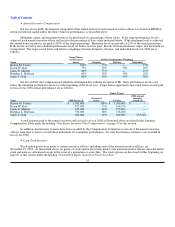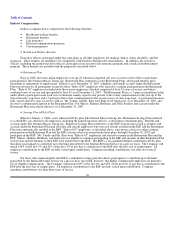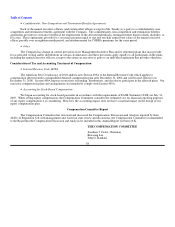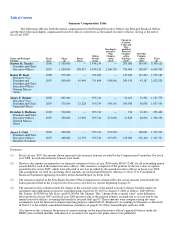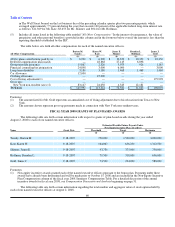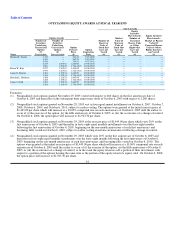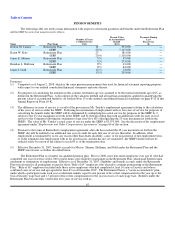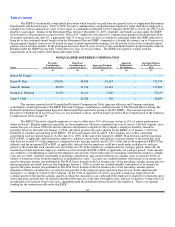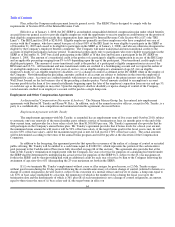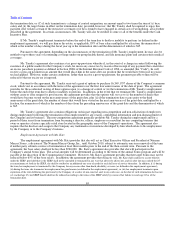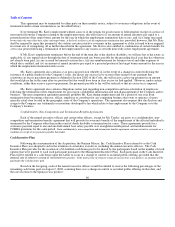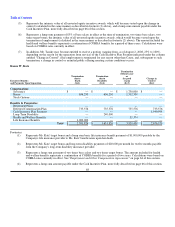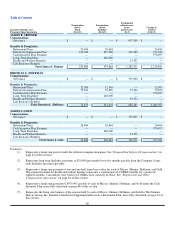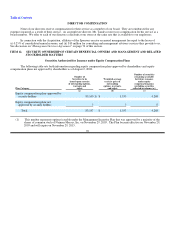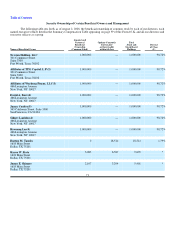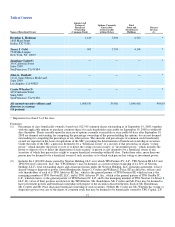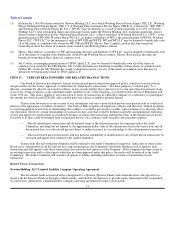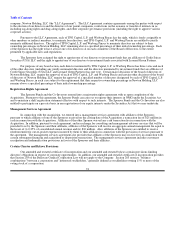Neiman Marcus 2007 Annual Report Download - page 69
Download and view the complete annual report
Please find page 69 of the 2007 Neiman Marcus annual report below. You can navigate through the pages in the report by either clicking on the pages listed below, or by using the keyword search tool below to find specific information within the annual report.
Table of Contents
Plan, rather the Company makes payment from its general assets. The KEDC Plan is designed to comply with the
requirements of Section 409A of the Internal Revenue Code.
Effective as of January 1, 2008, the DC SERP is an unfunded, nonqualified deferred compensation plan under which benefits
are paid from our general assets to provide eligible employees with the opportunity to receive employer contributions on the portion of
their eligible compensation that exceeds the compensation limit imposed by Internal Revenue Code Section 401(a)(17) (the "IRS
Limit"). The IRS Limit for 2008 is $230,000. Eligible employees generally are those employees who have completed one year of
service with the Company, who have annual base pay of at least 80% of the IRS Limit (or were eligible to participate in the SERP as
of December 31, 2007 and ceased to be eligible to participate in the SERP as of January 1, 2008), and who are otherwise designated as
eligible by the Company's employee benefits committee. The Company will make transitional and non-transitional credits to the
accounts of eligible participants each pay period. Transitional credits apply only to participants who were eligible to participate in the
SERP as of December 31, 2007 but ceased participating in the SERP as of that date and became a participant in the DC SERP on
January 1, 2008. The amount of a transitional credit is the product of a participant's eligible compensation in excess of the IRS Limit
and an applicable percentage ranging from 0% to 6% depending upon the age of the participant. Non-transitional credits apply to all
eligible participants. The amount of a non-transitional credit is the product of a participant's eligible compensation in excess of the
IRS Limit and 10.5%. All transitional and non-transitional credits are credited to a bookkeeping account and vest upon the earlier of
(i) an eligible employee's attainment of five years of service, (ii) an eligible employee's attainment of age 65, (iii) an eligible
employee's death, (iv) an eligible employee's disability, or (v) a change of control (as defined in the DC SERP) while in the employ of
the Company. Notwithstanding the preceding, amounts credited to an account are subject to forfeiture in the event the employee is
terminated for cause. Accounts are credited monthly with interest at an annual rate equal to the prime interest rate published in The
Wall Street Journal on the last business day of the preceding calendar quarter. Vested amounts credited to an employee's account
become payable in the form of five annual installments beginning upon the later of the employee's separation from service and age 55,
or such later age as the employee may elect. Upon the employee's death or disability or upon a change of control of the Company,
vested amounts credited to an employee's account will be paid in a single lump sum.
Employment and Other Compensation Agreements
As discussed in "Compensation Discussion & Analysis," The Neiman Marcus Group, Inc. has entered into employment
agreements with Burton M. Tansky and Karen W. Katz. In addition, each of the named executive officers, except for Mr. Tansky, is a
party to a confidentiality, non-competition and termination benefits agreement, discussed below.
Employment Agreement with Mr. Tansky
The employment agreement with Mr. Tansky, as amended, has an employment term of five years until October 2010, subject
to automatic one-year renewals of the term if neither party submits a notice of termination at least six months prior to the end of the
then-current term, and provides for a base salary of not less than $1,300,000 per year. Mr. Tansky's agreement also provides that he
will participate in the Company's annual bonus plan. Mr. Tansky's agreement provides that if bonus levels for a fiscal year are met,
the minimum bonus amount he will receive will be 50% of his base salary, if the target bonus goal for the fiscal year is met, he will
receive 85% of his base salary, and if the maximum target goal is met, he will receive 170% of his base salary. The actual amounts
will be determined according to the terms of the annual bonus program and will be payable at the discretion of the Compensation
Committee.
In addition to the foregoing, the agreement provides that upon the occurrence of the earlier of a change of control or an initial
public offering, Mr. Tansky will be entitled to a cash bonus equal to $3,080,911, which represents his portion of the cash incentive
pool pursuant to the Cash Incentive Plan (more fully described on page 66 of this section). The agreement also provides that at the
time of Mr. Tansky's termination of employment with the Company, his years of service for purposes of calculating his benefit under
the SERP shall be determined by multiplying his actual service for purposes of the SERP by 2, subject to the 25-year maximum set
forth in the SERP, and by then providing him with an additional credit for each year of service by him to the Company following his
attainment of age sixty-five (65) (disregarding the 25-year maximum set forth in the SERP).
If (1) we terminate Mr. Tansky's employment without cause or if he resigns for good reason, or (2) Mr. Tansky resigns
without good reason during the 30 day period following the six month anniversary of a future change of control (referred to herein as a
change of control resignation), he will receive, subject to his execution of a mutual release and waiver of claims, a lump sum equal to
(A) 85% of base salary multiplied by a fraction, the numerator of which is the number of days during the fiscal year up to the
termination date and the denominator of which is 365, plus (B) if such termination is not a change of control resignation, an amount
equal to three times the sum of (i) base salary and (ii) the target bonus in effect on
64


